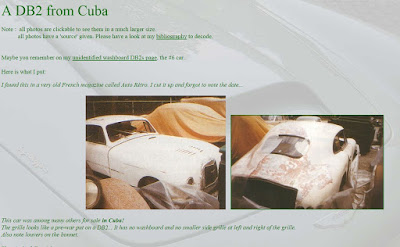The Aston Martin's story, and the probable truth
 |
| A 1957 DB 2/4 similar to the Aston Martin in Cuba. Wikipedia photo. |
He tells of handing out fuses, bulbs and other auto-repair necessities, and helping to fix a taxi radiator hose with a Band-Aid. He describes the progress and decay he sees side by side.
And he shares a revealing remark by a doctor who moonlights as a tricycle taxi operator about the island's dilemma.
"Communism does not work," the doctor tells him, "but capitalism has no conscience."
Yet when it comes to the rare 1958 Aston Martin DB 2/4 he saw in Cuba, Ward reveals a rookie error.
He fell for The Story.
Everything in Cuba has a story – amusing or romantic or poignant or all of these things. Sometimes it is true. Sometimes it is embroidered from a single thread of fact. Sometimes, you suspect, it has been composed on the spot.
Storytelling is part of the Cuban culture, a tradition nourished by decades of sharing word-of-mouth rumours and speculation as antidote to the sanctioned stories of the state media.
The Aston's story, related by a woman who says she is its owner, is that the car was a gift from a "British official" who had to leave unexpectedly and could not export it. Now she was seeking Ward's assessment of the sports car's potential value, presumably to an offshore buyer.
It sounds a bit like the fall of Saigon, the elegant diplomat clinging to a Huey skid and calling, "Cheerio, my dear – enjoy the Aston!"
None of this makes sense. Great Britain never closed its embassy in Cuba, and foreign nationals, envoys or otherwise, have generally found it possible to leave with vehicles they brought to Cuba in the first place.
Much more likely is that the Aston Martin was imported by a rich Cuban business owner to compete in the island's burgeoning car racing scene.
Indeed, an article by Bill Noon for a publication of the Aston Martin Owners Club confirms that an DB 2/4 Mark III with racing-specification, 214-horsepower engine – one of just two cars so produced – was delivered new for entry in the Cuban Grand Prix in October 1958.
 |
| Aston Martin DB 2/4 was an early hatchback. Theodulf/Wikipedia. |
There was a moment in the early 1990s when a collector could have secured this prize. Desperate for cash after the collapse of its longtime benefactor, the Soviet Union, Cuba relaxed its prohibition on vehicle exports, and well-heeled enthusiasts swooped in to grab the very best of Cuba's rolling treasures.
This was the way another Aston Martin, a DB2, found its way to Germany. That car – the story goes – was originally owned by the Bacardi family.

Perhaps the rarer DB 2/4 escaped notice in this period. Or perhaps it did come to the attention of a buyer – our Britisher? – who could not complete the paperwork before Cuba closed the door again on car exports, and left it with a Cuban friend.
If Jonathan Ward suspects any of this alternate history, he doesn't say. What he does share is his conclusion, after his first-time visit, that the Aston Martin and all of Cuba's cars belong in Cuba, and not in the hands of foreign collectors and restorers like himself.
Maybe he didn't fall for The Story after all.



Comments